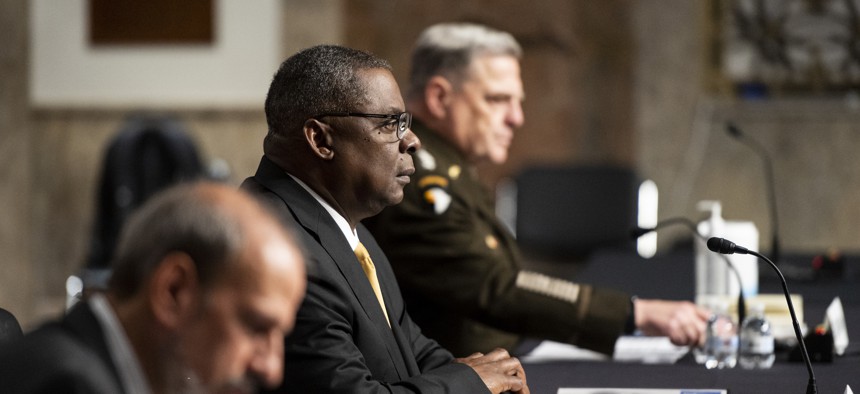
From left, Under Secretary of Defense Michael McCord, Secretary of Defense Lloyd Austin III, and Chairman of The Joint Chiefs Of Staff General Mark Milley prepare to testify during the Senate Armed Services Committee hearing on the Defense Authorization Request for fiscal year 2022 on Thursday, June 10, 2021. Photo by Bill Clark/CQ-Roll Call, Inc via Getty Images
If China Is the No. 1 Threat, Why Doesn’t the 2022 Budget Reflect It?
The Middle East will continue to demand resources even as troops withdraw from Afghanistan.
For the last decade, combatant commanders for the Middle East and Asia-Pacific have found themselves competing for warships, aircraft, and surveillance assets. Decisions often favored U.S. Central Command and its need to counter Iranian-backed militias, the Taliban, ISIS, and a proliferating roster of insurgent groups.
This budget year was supposed to mark the turning point.
“The Department must be ready to meet and keep pace with our competitors and, if necessary, to fight and win the next war, not the last one,” Defense Secretary Lloyd Austin told the Senate on Thursday, noting the drawdown in Afghanistan. Now, it’s time to focus on China.
“From a strictly military standpoint, I think China is the No. 1 threat as we go forward,” said Joint Chiefs Chairman Gen. Mark Milley, who was testifying alongside Austin.
But the 2022 budget request shows that despite withdrawal in Afghanistan, war operations in the Middle East will continue to demand resources that might have flowed to Indo-Pacific Command.
The military footprint at regional bases in Kuwait, Qatar, UAE, and other Middle East locations used to support forces in Iraq, Syria and Afghanistan will drop by only 2,000 personnel to 43,900—even though force levels in Afghanistan will drop from 3,500 to what’s needed to support the embassy. Force levels in Iraq and Syria increased by 3,000 personnel for fiscal year 2021, according to budget documents, however the exact numbers of forces in either country is not publicly reported by the Pentagon.
Each of the services outlined a substantial continued presence in the region too. To support Operation Inherent Resolve and Operation Freedom’s Sentinel, the Air Force seeks about $10 billion to continue operations and provide “over the horizon” support for the Afghan security forces after U.S. troops leave; the Army seeks $10.4 billion; the Navy seeks about $5.6 billion—$859 milion of which is for flight operations and $2.9 billion is for ship operations. The Marine Corps is asking for $887 million and the Space Force seeks $75 million.
On top of that, the Pentagon is seeking an additional $3.3 billion to continue training Afghan security forces, however plans on how to do that from outside the country aren’t finalized.
Even in intelligence, surveillance, and reconnaissance, or ISR, which is in high demand to help U.S. Indo-Pacific Command leaders keep tabs on Chinese construction in the South China Sea and missile tests by North Korea, CENTCOM’s immediate needs are given priority. “These systems are used to enhance force protection,” the Pentagon said in its 2022 budget submission.
At the hearing Thursday, several senators questioned whether the military should be pressing forward with its plans to retire RQ-4 Global Hawk Block 30 aircraft in light of demand that is increasing, not falling.
“No combatant commander has ever gotten all the ISR they want,” Milley said. “It’s one of those commodities that is in high demand, all the time, and no one is ever completely satisfied.”
“It’s all a function of risk,” Milley continued. “Where you take risk, what your priority is.”
For now, it’s force protection for withdrawing troops.
“We’re doing everything within our power, our capability, to make sure that our troops that are forward deployed have adequate protection,” Austin told senators on Thursday.
In the much larger Indo-Pacific theater, the Pentagon is seeking a total of $66 billion for its presence, including $5.1 billion for the Pacific Deterrence Initiative, the new fund devoted to countering China. More than half of that fund will be used to buy one Arleigh Burke-class guided missile destroyer and one Zumwalt-class guided missile destroyer.
“There is nothing you fund that doesn’t take money away from somebody else,” said Anthony Cordesman, who holds the Arleigh A. Burke chair in strategy at the Center for Strategic and International Studies. The enduring presence in the Middle East “will be about Iran, Iraq, and the stability of the core CENTCOM countries.”
If the Pentagon maintains its current footprint in the Middle East, to counter Iran, to support the Afghan government and to continue its operations in Iraq, will it be able to fully execute its refocus on China? That depends on whether the current presence is going to taper off, or if the over-the-horizon support turns into a persistent presence of airpower, said Stacie Pettyjohn, a former director of strategy and doctrine for the Air Force who is now the director of the defense program at the Center for a New American Security.
Last month, the Wall Street Journal reported the Pentagon was sending its sole Pacific theater aircraft carrier, the USS Ronald Reagan, to the Gulf to provide CENTCOM additional airpower support. That transit has not occurred and the carrier is still in the Pacific, the Navy said Thursday. The Navy would not discuss whether the carrier would eventually be sent to CENTCOM.
“There is a zero-sum element to it, because we have a finite amount of force structure,” Pettyjohn said. “A lot of the assets you really need for any sort of operations or preparing for a high-end fight in the Indo-Pacific are similar, at least from the air and naval side.”
“So you do end up sometimes taking from one area or another,” Pettyjohn said. “If you are really trying to be present and compete day to day in all of these places, that’s a lot of demand on the services to supply those forces.”




